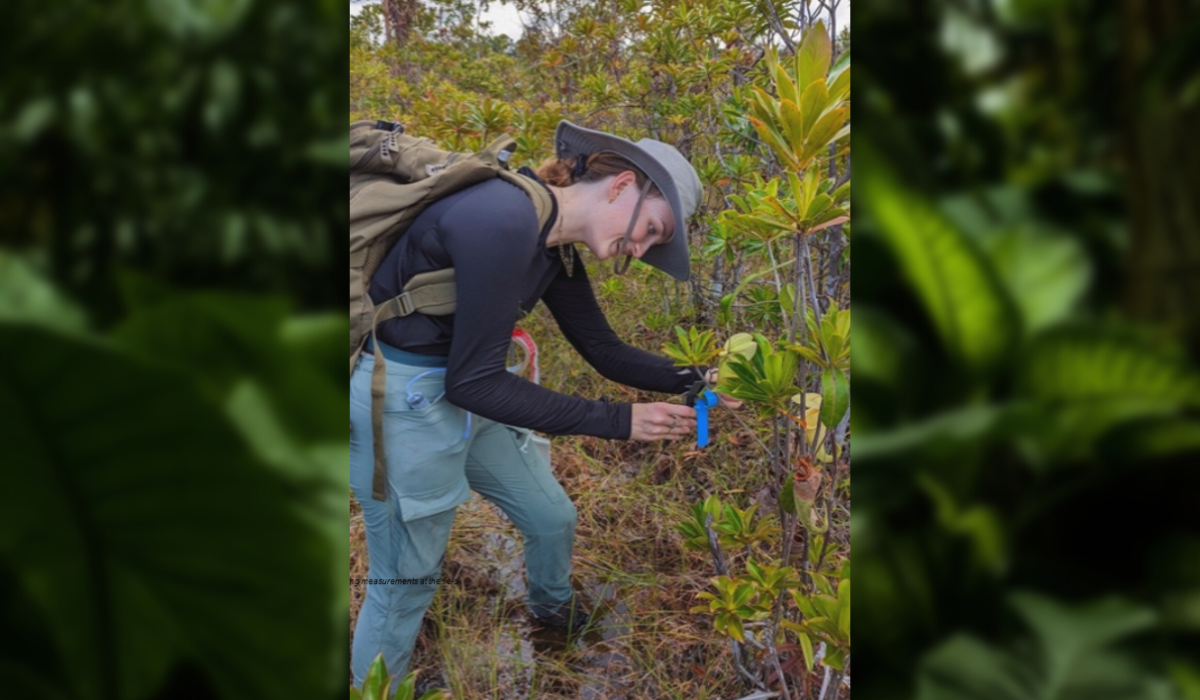This blog, submitted by Charlotte Andrew (PhD in Zoology), was the winner of the 2023 Research Blog competition.
Carnivorous plants across the globe employ a variety of extraordinary mechanisms to attract and capture their prey. The Venus fly trap is undoubtedly the most ubiquitous, but there are in fact much more prolific predators within the carnivorous plant world whose trapping methods seem even more effortless. Nepenthes pitcher plants are a seemingly harmless but highly potent threat for an unsuspecting insect. By luring prey to land on the colourful rims of their cup-like pitfall traps, the extremely slippery surface proves fatal as insects inevitably slip and slide into the depths of the killer plant. Here, a complex fluid entraps the prey allowing the plant to digest it over time.

I have been studying Nepenthes rafflesiana, a particularly interesting species due to its extremely sticky pitcher fluid and high lid angle, making the influx of rainfall inevitable. This morphology, coupled with the extreme tropical rains experienced in Nepenthes habitats presents an intriguing problem: how effective would diluted pitcher fluid or near overflowing traps be at retaining captured prey?
In January, I embarked on my first field trip to the heart of Borneo where I have been working on the plants in their native environmental conditions. My initial focus is on the fluctuations of fluid levels within individual pitchers and how the fluid level affects the amount of prey captured. By recording the volume of rainfall at the field site and the variation in fluid level within the pitcher during a shower, I have been able to quantify the effectiveness of the pitcher lid at providing shelter from rainfall. Initial results indicate that the lid does allow water to enter. Therefore, the fluid does indeed become diluted and increase in volume following rain.

The next stage was to test the change in viscoelasticity (‘stickiness’) of the fluid as it becomes diluted. I have been using a portable extensional rheometer in my bedroom, come laboratory, here in Borneo to essentially stretch droplets of the fluid and record their behaviour during extension to evaluate their viscoelasticity. These measurements uncovered an interesting phenomenon whereby even an extremely diluted pitcher fluid sample hardly deviates in behaviour from pure samples. I plan on furthering this work during my 5-month stay here but I am extremely excited by the idea that the pitcher’s fluid is still able to retain its trapping ability despite being subjected to frequent tropical rains!
In addition, I have found that very young pitchers exhibit strikingly uniform starting fluid levels sitting at almost exactly 50% of the total height of the pitcher. However, day-to-day variations in response to weather conditions are a regular occurrence. In order to investigate this I am manipulating the fluid height within test pitchers to see how much prey is captured at ‘low’, ‘medium’ and ‘high’ fluid heights. Every morning at sunrise, I visit each of my experimental pitchers and count the number of insects they have captured in the past 24 hours- this can vary anywhere from 0 to 30 ants, flies, spiders, beetles or moths each day! Initial indications suggest that a higher fluid height may in fact equate to a higher rate of prey capture. This is likely because many pitchers possess a slippery waxy lining on the walls in their uppermost section making it harder for prey to latch onto the walls and escape.The combination of both fundamental effects of rainfall on pitcher fluid lead to an interesting possible conclusion: the positive effect of increased fluid level on prey capture outweighs negative dilutive effects. The trade-off between optimal fluid height and resource heavy excess fluid production could be overcome if the plant is able to use rainfall to its advantage to enhance trapping ability.





